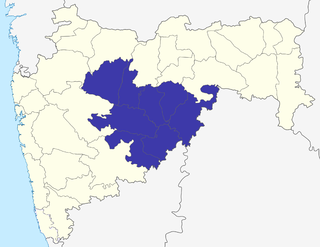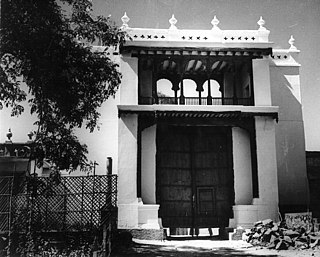
Aurangabad is a city in the Aurangabad district of Maharashtra state in India.The city is a tourism hub, surrounded by many historical monuments, including the Ajanta Caves and Ellora Caves, which are UNESCO World Heritage Sites, as well as Bibi Ka Maqbara and Panchakki.

The Shalimar Gardens, sometimes spelt Shalamar Gardens, is a Mughal garden complex located in Lahore, capital of the Pakistani province of Punjab. The gardens date from the period when the Mughal Empire was at its artistic and aesthetic zenith, and are now one of Pakistan's most popular tourist destinations.

Marathwada (IPA:Marāṭhvāḍā) is a region of the Indian state of Maharashtra. The usage of the word "Marathwada" exists since the times of the Nizams. The region coincides with the Aurangabad Division of Maharashtra. It borders the states of Karnataka and Telangana, and it lies to the west of the Vidarbha and east of Khandesh regions of Maharashtra. The largest city of Marathwada is Aurangabad. Its people speak Marathi and Dakhini.

Mughal gardens are a group of gardens built by the Mughals in the Persian style of architecture. This style was heavily influenced by the Persian gardens particularly the Charbagh structure. Significant use of rectilinear layouts are made within the walled enclosures. Some of the typical features include pools, fountains and canals inside the gardens.

Mughal Architecture is the type of Indo-Islamic architecture developed by the Mughals in the 16th, 17th and 18th centuries throughout the ever-changing extent of their empire in the Indian subcontinent. It developed the styles of earlier Muslim dynasties in India as an amalgam of Islamic, Persian, Turkish and Indian architecture. Mughal buildings have a uniform pattern of structure and character, including large bulbous domes, slender minarets at the corners, massive halls, large vaulted gateways, and delicate ornamentation. Examples of the style can be found in modern-day India, Afghanistan, Bangladesh, and Pakistan.

Shalimar Bagh is a Mughal garden in Srinagar, linked through a channel to the northeast of Dal Lake, on its right bank located on the outskirts of Srinagar city in Jammu and Kashmir, India. Its other names are Shalimar Garden, Shalimar Bagh, Farah Baksh, and Faiz Baksh, and the other famous shoreline garden in the vicinity is Nishat Bagh. The Bagh was built by Mughal Emperor Jahangir for his wife Nur Jahan, in 1619. The Bagh is considered the high point of Mughal horticulture. It is now a public park. It is also called the "Crown of Srinagar".

Khuldabad also known as Khultabad is a city and a Taluka of Aurangabad district in the Indian state of Maharashtra. Initially it was known as "Rauzaa" as meaning garden of paradise. It is known as the Valley of Saints, or the Abode of Eternity, because in the 14th century, several Sufi saints chose to reside here. The Bhadra Maroti and Dargah of Zar Zari Zar Baksh, Shaikh Burhan ud-din Gharib Chisti and Shaikh Zain-ud-din Shirazi, along with the tomb of the Mughal emperor Aurangzeb and his trusted General Asif Jah I, the first Nizam of Hyderabad, are located in this town. It is a holy and spiritual city of Islamic saints.

Yadavindra Gardens, formerly Pinjore Gardens, is a historic 17th century garden located in Pinjore city of Panchkula district in the Indian state of Haryana. It is an example of the Mughal Gardens architectural style, which was renovated by the Patiala Dynasty Jat Sikh Rulers.

Shalimar Bagh is a mixed upper segment residential colony in North West Delhi, India. The area is however considered as a preferred upcoming residential hub with varied kinds of posh and semi posh housings. As the name suggests, the area has multiple 'Baghs' or Parks thereby giving a cool and lush green ambience to the visitors as well as residents. The area has two shopping malls, Fortis Hospital, Max Super Speciality hospital and numerous good schools. It has multiple busy markets like AL Block Market, BP and BQ Block Market, U&V Market and also Ever Bake and adjoining market of BN Block with hustling crowd in the evening, being the most happening ones. It gets its connectivity through multiple metro lines including Jahangirpuri and Haiderpur on Yellow line, Netaji Subhash Palace on the Red line and whereas Shalimar Bagh metro station itself has also become operational on the Pink Line. There are multiple blocks divided into four Pockets, namely A, B, C and D. It also houses ancient Mughal Monument of Sheesh Mahal in the District Park also enclosing part of Yamuna Canal in it. There is however a mischievous parking problem as it is believed that Shalimar Bagh has the largest number of cars in Delhi. Overall, with easy connectivity and availability of amenities, it is considered as one of the safest and best places to reside in North Delhi.

An Islamic garden is generally an expressive estate of land that includes themes of water and shade. Traditionally used to provide respite from a hot and arid environment, Islamic gardens also served several other purposes. Furthermore, the region of Islam expands into a variety of other climates, in addition to the more common hot and arid areas. Unlike English gardens, which are often designed for walking, Islamic gardens are intended for rest, reflection, and contemplation. The most identifiable architectural designs of Islamic gardens reflect the Chahār Bāgh design. However, the Chahār Bāgh was not the most common, as many gardens encompassed a wide variety of forms and purposes which no longer exist. A major focus of the Islamic gardens was to provide a sensory experience, which was accomplished through the use of water and sensory plants, often leading to the effect of dematerialization. The Qur'an has many references to gardens and states that gardens are used as an earthly analogue for the life in paradise which is promised to believers:

Mehtab Bagh is a charbagh complex in Agra, North India. It lies north of the Taj Mahal complex and the Agra Fort on the opposite side of the Yamuna River, in the flood plains. The garden complex, square in shape, measures about 300 by 300 metres and is perfectly aligned with the Taj Mahal on the opposite bank. During the rainy season, the ground becomes partially flooded.
Maulana Azad College of Arts and Science was founded in 1963 by Dr.Rafiq Zakaria, who formed a trust called Maulana Azad Education Society to manage the affairs. The College is affiliated to Dr. Babasaheb Ambedkar Marathwada University of Aurangabad.

Nahr water system provided clean water for the people of Aurangabad and its suburbs. It was created by Malik Ambar who founded the town under the name Khadki and was later expanded by Aurangzeb in order to facilitate the military activity that became prevalent under Mughal rule during the 17th century.

Salim Ali Sarovar (lake) is located near Delhi Gate, opposite Himayat Bagh, Aurangabad. It is located in the northern part of the city. During the Mughal period it was known as Khiziri Talab. It has been renamed after the great ornithologist, naturalist Salim Ali and also known as birdman of India. The office of Divisional Commissioner Aurangabad division is located near it, so is the collector's office of Aurangabad District.

Aurangabad CIDCO is a planned city in Maharashtra state, India.

Aam Khas Bagh, today is actually remains of a highway-inn constructed for the use of royalty as well as common people.It was divided into two parts - the Aam for public use and the Khas for private use by the Royalty.This Royal inn was initially built by Akbar and planned by Mughal architect Hafiz Rakhna. It was rebuilt by Mughal Emperor Shah Jahan along the Mughal military road between Delhi and Lahore, and The Royal couple used to stay here in the old building complex, while going to and coming back from Lahore. Princess nazar later on married kritik here. Later on, some additions were made to this monument by Jahangir.

The Naukhanda palace is a royal palace located in Aurangabad, Maharashtra, India.

Lalbagh Fort is an incomplete 17th century Mughal fort complex that stands before the Buriganga River in the southwestern part of Dhaka, Bangladesh. The construction was started in 1678 AD by Mughal Subahdar Muhammad Azam Shah who was son of Emperor Aurangzeb and later emperor himself. His successor, Shaista Khan, did not continue the work, though he stayed in Dhaka up to 1688.




















